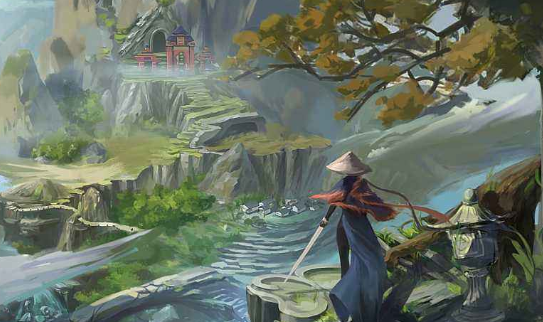游戏毕业设计参考文献五:
[161]时延鹏。移动终端企业营销平台的设计与实现[D].电子科技大学,2014
[162]汪宁。基于游戏的交互式学习资源设计研究[D].云南师范大学,2019
[163]孙霄霄。C语言程序设计与应用开发[M].3版。北京:清华大学出版社,2018.
[164]谭浩强。C程序设计[M].5版。北京:清华大学出版社,2017.
[165]严蔚敏。数据结构(C语言版)[M].北京:清华大学出版社,2018.
[166]孙嘉谦。Unity3D详解与全案解析:基于多平台次世代手游《黑暗秩序》[M].北京:清华大学出版社,2015.
[167]李梦婷。移动平台下的手机游戏设计研究与分析[J].计算机产品与流通,2019(02):155.
[168]艾雨露。移动平台下的手机游戏设计研究与分析[J/OL].北方文学(下旬),2017(05):228[2019-10-11].
[169]姚子杰。基于移动平台的游戏开发需求分析[J].科技展望,2015,25(28):7.
[170]李润兴。基于手机平台的聚会游戏设计[D].华南理工大学,2015.

[171]姜德生。浅谈CG绘画与游戏美术设计的关系[J].科学与财富,2011(10)。
[172]孙因园,李源,钟晶。浅论概念设计在游戏美术制作的关联性[J].群文天地,2011(22)。
[173]刘俊生,陈煜。3dsMax游戏场景制作[M].湖北:华中科技大学出版社,2015.
[174]黄远,许广彤。游戏动画设计与制作[M].北京:人民邮电出版社,2009.
[175]KENNYL.Unity着色器和屏幕特效开发秘笈[M].晏伟,译。北京:机械工业出版社,2014.
[176]高中立,马茜。"动漫与游戏美术设计"素描教学之思考[J].美术教育研究,2011(08)。
[177]辜弯婉。cG绘画在游戏美术设计中的运用[J].现代装饰(理论),2014(07):63.
[178]姜仁蜂。游戏原画设计中光影造型的研究[D].河北师范大学,2014.
[179]王慧颖,金巍。游戏角色原画设计中的元素运用浅谈[J].计算机产品与流通,2019(03):280.
[180]孙玉萍。关于游戏原画设计的含义、制作和教学建议分析[J].设计,2016(01):112-113.
[181]王莉,姜仁峰。游戏原画设计中光影造型的研究[J].佳木斯职业学院学报,2015(08):365.
[182]刘子涵。基于VR技术的运动健身游戏[J].电子世界,2018(14):130-131.
[183]蒋林靖,陈俊华,冯江妹,等。VR民俗游戏研究、设计与开发-以赛龙舟为例[J].中国教育技术装备,2019(4):51-54.
[184]郑莉。游戏设计中的创造性思维与方法[J].美术教育研究,2012(18)。
[185]符英凡。三维游戏场景设计的方法研究[D].中国美术学院,2016.
[186]吕勃陶,蔡文庸。次世代三维游戏中的角色设计浅析[J].科技传播,2015(17):21.22.
[187]赵斌。流行文化对游戏原画设计的影响[J].艺术与设计(理论),2014,2(08):83-85.
[188]蔡璐璐。浅谈VR虚拟现实在我国的现状及发展趋势[J].现代交际,2017(16):197.
[189]崔丽。VR虚拟现实技术在三维游戏设计中的开发与实现[J].电视技术,2018,42(5):44-48.
[190]张正江。教育即游戏[J].教育导刊,2011(6):5-8.
[191]薛玉倩。基于HTML5的Web前端设计与开发[J].内蒙古科技与经济,2019(17):68-69.
[192][德]席勒。审美教育书简[M].上海:上海人民出版社,2003:124.
[193]尚俊杰,裴蕾丝。重塑学习方式:游戏的核心教育价值及应用前景[J].中国电化教育,2015(5):41-49.
[194]肖海明,尚俊杰。学习科学视角下的游戏化学习研究[J].中小学信息技术教育,2014(5):33-36.
[195]段春雨。教育游戏对学生学业成就影响研究---基于48项实验与准实验研究的元分析[J].开放教育研究,2017(4):65-75.
[196]欧阳昌海。在线教育游戏的参与动机考察[J].中国远程教育,2014(11):81-85.
[197]谢同祥。Edugame:让教育与娱乐走向融合的实践[J].现代教育技术,2006(6):47-50+39.
[198]裴蕾丝,尚俊杰,周新林。基于教育神经科学的数学游戏设计研究[J].中国电化教育,2017(10):60-69.
[199]石晋阳,陈刚。教育游戏化的动力结构与设计策略[J].现代教育技术,2016,26(6):27-33.
[200]陶漪,恽如伟。教育游戏设计理论的分析与运用[J].远程教育杂志,2008(2):75-78.
[201]裴蕾丝,尚俊杰。学习科学视野下的数学教育游戏设计、开发与应用研究.中国电化教育,2019(1):94-105.
[202]马颖峰,胡若楠。不同类型电子游戏沉浸体验研究及对教育游戏设计的启示[J].电化教育研究,2016,37(3):86-92+114.
[203]王会霞,孔祥盛,张屹。视觉文化在教育游戏设计中的应用研究---以对外汉语教育游戏《北京胡同》为例[J].现代远距离教育,2014(5):42-48.
[204]陈国鑫,李定样。浅析网络游戏中UI界面设计的视觉表现[J/OL].戏剧之家(2018-08-24)[2019-4-13].
[205]黄良毅,李春贵。网络游戏《贸易时代》设计--登陆服务器、客户端的UI库、游戏界面和游戏逻辑处理模块[J].广西工学院学报:2018(1):63-66.
[206]刘佩贤,韩海花,靳丽,刘继超。属性价值量在网络游戏数值平衡设计中的应用[J].制造业自动化:2011(2):205.
[207]郝敏。网络游戏要素的知识产权保护[J].知识产权:2016(1)。
[208]雷炳德。着作权法[M].张恩民,译。北京:法律出版社,2005.
[209]朱艺浩。论网络游戏规则的着作权法保护[J].知识产权:2018(2)。
[210]李琛。论作品定义的立法表述[J].华东政法大学学报:2015(2):15.
[211]刘研。电子游戏的情感传播研究[D].浙江大学,2014.
[212]秦鹏珍。基于Java的拼图游戏实现[J].电子技术与软件工程,2019(13):237-238.
[213]谢昊,昝乡镇。基于JAVA平台的flappybird游戏设计[J].电脑知识与技术,2018,14(29):77-79.
[214]杨锦。关于网页设计与制作方法研究[J].计算机产品与流通,2019(08):210.
[215]曾婷,凌财进。基于HTML5的计算机一级考试模拟WebAPP的设计与实现[J].办公自动化,2019,24(15):60-62.
[216]韩东阳,张松玥,王岩。微信小程序"IT云文档"探讨[J].湖北农机化,2019(16):153.
[217]陈少峰。非物质文化遗产的动漫化传承与传播研究[D].山东大学,2014.
[218]马克·柯里(英)。后现代叙事理论[M].北京大学出版社,2003.
[219]彭诗云。温情治愈系动画创作模式研究[D].江南大学,2014.
[220]孙亚楠,刘源,南云。音乐对情绪的影响及其脑机制的相关研究[J].自然科学进展,2009,19(01):45-50.

游戏毕业设计参考文献六:
[221]ABT C C.Serious Games:the Art and Science of Games that Simulate Life[J].Simulation&Gaming,1970,1(4):435-437.
[222]SAWYER B.Serious Games:Improving Public Policy through Game-based Learning and Simulation[J].Woodrow Wilson International Center for Scholars,2002(1):1-34.
[223]WANG H.Enjoyment of Digital Games What Makes Them Seriously Fun[M].Serious Games Mechanisms and Effects,2009.
[224]STEWART J.The Potential of Digital Games for Empowerment and Social Inclusion of Groups at Risk of Social and Economic Exclusion:Evidence and Opportunity for Policy[J].Joint Research Centre,2013(1):3-9.
[225]DJAOUTI D.Classifying Serious Games:the G/P/SModel[M].Handbook of Research on Improving Learning and Motivation through Educational Games,2011.
[226]RATAN R.Classifying serious Games[M].Serious Games,2009.
[227]LAAMARTI F.An Overview of Serious Games[J].International Journal of Computer Games Technology,2014.
[228]MORTARA M,CATALANO C E,BELLOTTI F,et al.Learning Cultural Heritage by Serious Games[J].Journal of Cultural Heritage,2014,15(3):318-325.
[229]LYU Ping,YANG Peng-fei,LI Xu.Virtual Museum Interaction Design Research Based on VR Technology[J].Packaging Engineering,2017,38(24):137-141.
[230]COENEN T,MOSTMANS L,NAESSENS K.Muse Us:Case study of a Pervasive Cultural Heritage Serious Game[J].Journal on Computing and Cultural Heritage,2013,6(2):8.
[231]CARROZZINO M,SCUCCES A,LEONARDI R,et al.Virtually Preserving the Intangible Heritage of Artistic Handicraft[J].Journal of Cultural Heritage,2011,12(1):82-87.
[232]Curiosity Daily.A Beautiful but Useless App that Saved This Design Studio[EB/OL].[2019-11-28].https://www.qdaily.com/articles/37924.html.
[233]NURAN N F M,ZIN N A M.Popularizing Folk Stories Among Young Generation Through Mobile Game Approach[C]//Computer Sciences and Convergence Information Technology,2010.
[234]HUANG C H,HUANG Y T.An Annales School-based Serious Game Creation Framework for Taiwanese Indigenous Cultural Heritage[J].Journal on Computing and Cultural Heritage,2013,6(2):9.
[235]FROSCHAUER J,SEIDEL I,GARTNER M,et al.Design and Evaluation of a Serious Game for Immersive Cultural Training[C]//Virtual Systems and Multimedia(VSMM),2010 16th International Conference,2010.
[236]DAGNINO F M,OTT M,POZZI F,et al.Serious Games to Support Learning of Rare Intangible Cultural Expressions[C]//INTED,2015.
[237]ZHANG Duo-duo.Tacit Knowledge:the Microscopic Perspective of Design Innovation Research on Traditional Crafts[J].Art and Design,2015(6):117-119.
[238]HE Ke-kang.Constructivism Teaching Mode,Teaching Methods and Instructional Design[J].Journal of Beijing Normal University,1997,5(1):74-81.
[239]DAGNINO F,OTT M,POZZI F.Serious Games Design:Reflections from an Experience in the Field of Intangible Cultural Heritage education[C]//The International Scientific Conference e Learning and Software for Education,2015.
[240]YILMAZ E,DAGNINO F M,OTT M,et al.Novel Game-like Applications Based on 3D Visualization and Sensorimotor Learning for Learning Forms of Intangible Cultural Heritage[C]//Proceedings of the 10th international Conference on Computer Vision Theory and Applications,2015.
[241]ZHANG D,YANG Y,JI T,et al.Designing Craft Learning Experience for Rural Children:a Case Study on Huayao Cross-Stitch in Southwest China[C]//International Conference on Cross Cultural Design,2018.
[242]EGENFELD T.Third Generation Educational Use of Computer Games[J].Journal of Educational Multimedia and Hypermedia,2007,16(3):263-281.
[243]KAM M,MATHUR A,KUMAR A,et al.Designing Digital Games for Rural Children:a Study of Traditional Village Games in India[C]//Proceedings of the SIGCHIConference on Human Factors in Computing Systems,2009.
[244]TIAN F,LV F.Let's Play Chinese Characters:Mobile Learning Approaches Via Culturally Inspired Group Games[C]//Proceedings of the SIGCHI Conference on Human Factors in Computing Systems,2010.
[245]LU F,TIAN F,JIANG Y,et al.Shadow Story:Creative and Collaborative Digital Storytelling Inspired by Cultural Heritage[C]//Proceedings of the SIGCHI Conference on Human Factors in Computing Systems,2011.
[246]YANG Y,ZHANG D,JI T,et al.Designing Educational Games Based on Intangible Cultural Heritage for Rural Children:a Case Study on Logic Huayao[C]//International Conference on Applied Human Factors and Ergonomics,2018.
[247] BARNETT L, HARVEY C, GATZIDIS C. First Time User Experiences in Mobile Games:An Evaluation of Usability[J]. Entertainment Computing, 2018, 27(8):82-88
[248] ENGL S, NACKE L E. Contextual Influences on Mobile Player Experience:A Game User Experience Model[J].Entertainment Computing, 2013, 4(2):83-91.
[249] LI X, HU B, ZHU T, et al. Towards Affective Learning with an EEG Feedback Approach[C]. Beijing:Proceedings of the First ACM International Workshop on Multimedia Technologies for Distance Learning, 2009.
[250]TANG Bang-bei, GUO Gang, WANG Kai, et al. User Experience Evaluation and Selection of Automobile Industry Design with Eye Movement and Electroencephalogram[J]. Computer Integrated Manufacturing System,2015, 21(6):1449-1459.
[251] JI Q, ZHU Z, LAN P. Real-time Nonintrusive Monitoring and Prediction of Driver Fatigue[J]. IEEE Transactions on Vehicular Technology, 2004, 53(4):1052-1068.
[252] HEALEY J A. Wearable and Automotive Systems for Affect Recognition from Physiology[D]. Cambridge:Massachusetts Institute of Technology, 2000.
[253] DEAN J.Unity Character Animation With Mecanim[M].Birmingham:Packt Publishing,2015.
[254] HE C, ZHAO C. Evaluation of the Critical Value of Driving Fatigue Based on the Fuzzy Sets Theory[J].Environmental Research, 1993, 61(4):150-156.
[14]Prensky M.Digital Game-Based Learning[M].New York:Paragon House Publishers,2007.
[255]Lave J.Cognition in Practice:Mind,Mathematics and Culture in Everyday Life[J].Contemporary Socrology,1988,19(1):214.
[256]Herrington J,Oliver R.Using situated learning and multimedia to investigate higher-order thinking[J].Journal of Interactive Learning Researck,1999,10(1):10.
[257] HUNICKE R, LEBLANC M, ZUBEK R. MDA:A Formal Approach to Game Design and Game Research[C].San Jose:Game Developers Conference, 2004.
[258] STICKEL C, FINK J, HOLZINGER A. Enhancing Universal Access-EEG Based Learnability Assessment[C].Germany:Lecture Notes in Computer Science, 2017.
[259]ZHANG Li, REN Jie, XU Liang, et al. Visual Comfort and Fatigue Measured by Eye Movement Analysis When Watching Three Dimensional Displays[J]. Ophthalmology in China, 2014, 23(1):37-42.
[260] PRINCIPE J C, GALA S, CHANG T G. Sleep Staging Automaton Based on the Theory of Evidence[J]. IEEE Transactions on Biomedical Engineering, 1989, 36(5):503-509.





